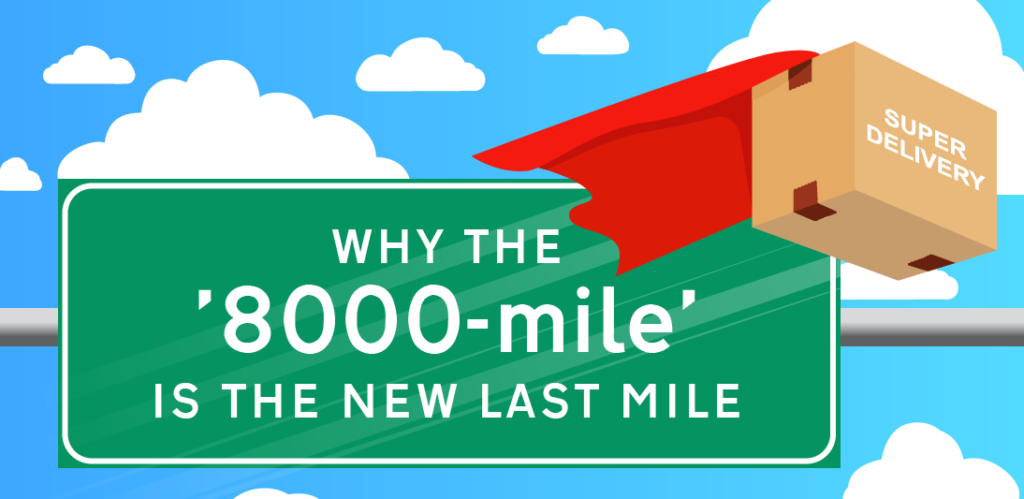July 13, 2021
Is 8000-miles the New Last-mile Delivery?

By Joe Fogg, Director Global Logistics, PCH International
PayPal just published a new report on consumer spending habits post-Covid and the findings suggest that brands need to find multichannel strategies to support customer choices. More than half (62%) of respondents from the U.S., UK, and Australia admitted to doing most of their purchasing online, while close to half said they discover new products on social media at least once a month, and two thirds (66.7%) said they’ve made a purchase directly through their phone at least once in the past month.
To seize opportunities, brands need to reassess existing infrastructure to support the new multichannel Direct-to-Consumer (D2C) opportunities. Successful brands combine a seamless digital solution with a fully integrated supply chain to offer an increasingly personalized online experience.
In a product’s journey from warehouse shelf to the customer, the “last mile” of delivery is the final step of the process — the point at which the package finally arrives at the buyer’s door. For many years, this has been considered to be pivotal in supply chain effectiveness and critical to customer satisfaction. It is also the most expensive and time-consuming part of the shipping process. However, with changing consumer spending habits and the emergence of D2C sales, brands should think about a ‘8,000 mile’ last-mile strategy.
Why an 8,000-mile last mile is essential for brands
The traditional distribution center is built on the premise that brands require a short last mile from the distribution center to the customer. The focus, until now, has been on delivering products quickly, efficiently, and cost-effectively. However, this model has hurt brands by bloating inventory, damaging working capital, and creating headline-making waste. Buying in bulk and piling high to support a great last mile is a strategy that leads to lost sales and discounting. Supply chains built on six-month lead times will never be responsive to ever-changing customer preferences. Planning and purchasing for next season is a strategy of hope as a substitute for a highly agile supply chain. Today’s buyers are also increasingly concerned about the socio-environmental impact of retailing. Unsold, returned and obsolete products are regularly destroyed, causing environmental and social damage.
Traditional supply chain companies are designed for high volume, large orders that are delivered to national and regional distribution centers. Their model is built on costly infrastructure and fixed assets. Buildings were built to handle pallets, not parcels. The objective was to optimize cubic capacity through dense storage and minimize loading bays based on the assumption of lots of large vehicles taking away goods every hour. They weren’t built to handle direct-to-consumer orders that are customized and personalized to provide a unique and compelling experience.
PCH International has an asset-light solution that can be customized for every single brand, every single product and every single market. We have built out our own facilities and resources, ecosystems, processes, as well as operational and logistical expertise to support the 8,000-mile last mile.
Products suited to D2C are often high value, low density, and light. Once packaged, they can be efficiently shipped. We leverage economies of scale by consolidating multiple products from multiple brands together for parts of the journey and providing customer-centric last mile solutions.
Demand-driven solutions are essential
Solutions must be demand-driven – one global stock location, holding minimum inventory. Working with suppliers, PCH obtains a low minimum order quantity and production runs, enabling fast replenishment of faster-moving products whilst pushing back slow movers. We pick, pack, and ship products direct to end customers. We connect digitally to 8,000-mile carriers and local couriers. Our customers get visibility of order progress – satisfying the need for clear and concise information, giving them certainty, and a positive experience.
The solution improves responsiveness, shortens the order-to-cash cycle, and releases significant amounts of tied capital.
Packaging should be part of the experience
Innovative D2C brands are giving customers more than just a product, they’re using packaging to deliver an experience.
The shift from retail to online has turned packaging on its head. In retail, you need a big box with colorful images to grab attention but in the world of D2C small, well-designed packages are essential –efficiently packed with little to no waste. Smaller, flatter packages are easier to ship, and can be pushed through the consumer’s letterbox, rather than left on the doorstep. Carriers capture images of house numbers and post boxes instead of requiring people to be home to ‘sign for’.
Consumers instinctively dislike wasteful packaging. Creative packaging solutions can really make a brand stand out, and, especially if that packaging has a genuine sustainability story behind it, can be a huge brand differentiator.
D2C is changing the brand experience for consumers and changing the relationship they have with the brand. This relationship is increasingly more direct, more engaged, and more intimate. It is a relationship that thrives on communication and responsiveness and can only be achieved through digital connectivity.
The pace of change and the competing demands for product, marketing, and channel investment mean that very few brands are able to invest in their own D2C facility. For others, they simply don’t have the scale. To avoid making large capital investments and recurring fixed costs, it is best to leverage a facility with other brands. Whilst benefitting from economies of scale, digital technology ensures that brands receive tailored solutions, just like their customers. At PCH, we cultivate partnerships with suppliers and identify, audit, manage and deliver solutions for consumer brands. We minimize the risks of excess inventory, and we create the most efficient, flexible, reliable, and sustainable supply chains possible.